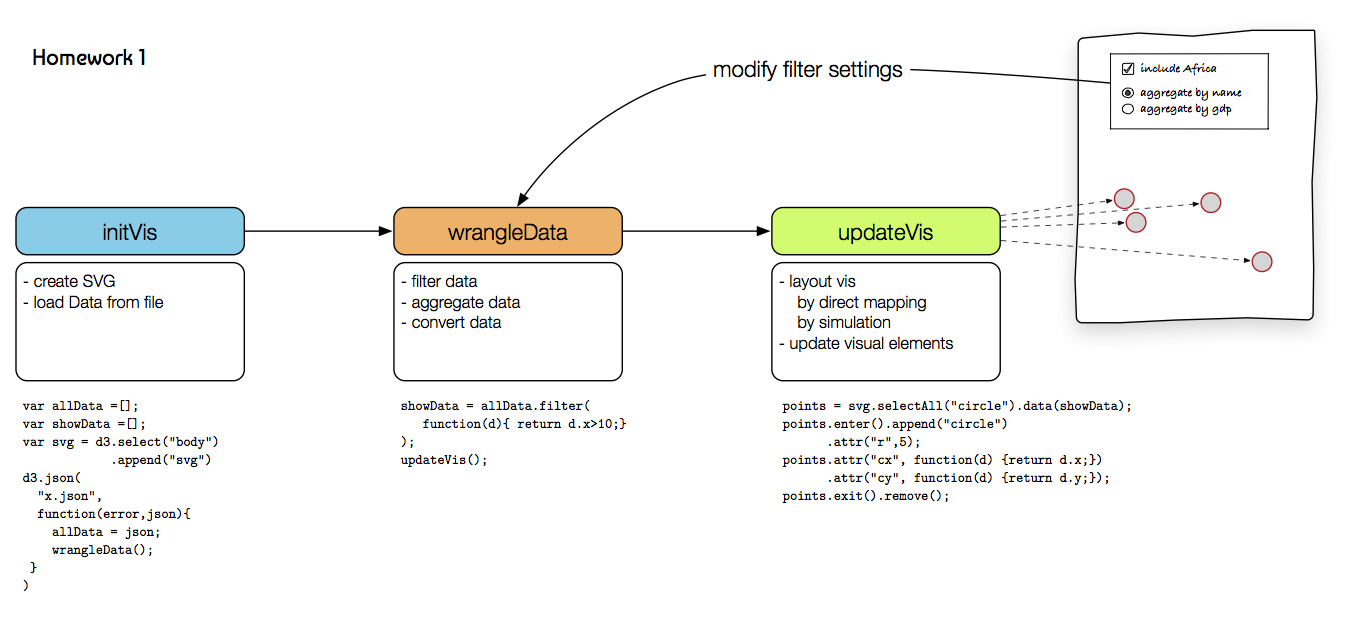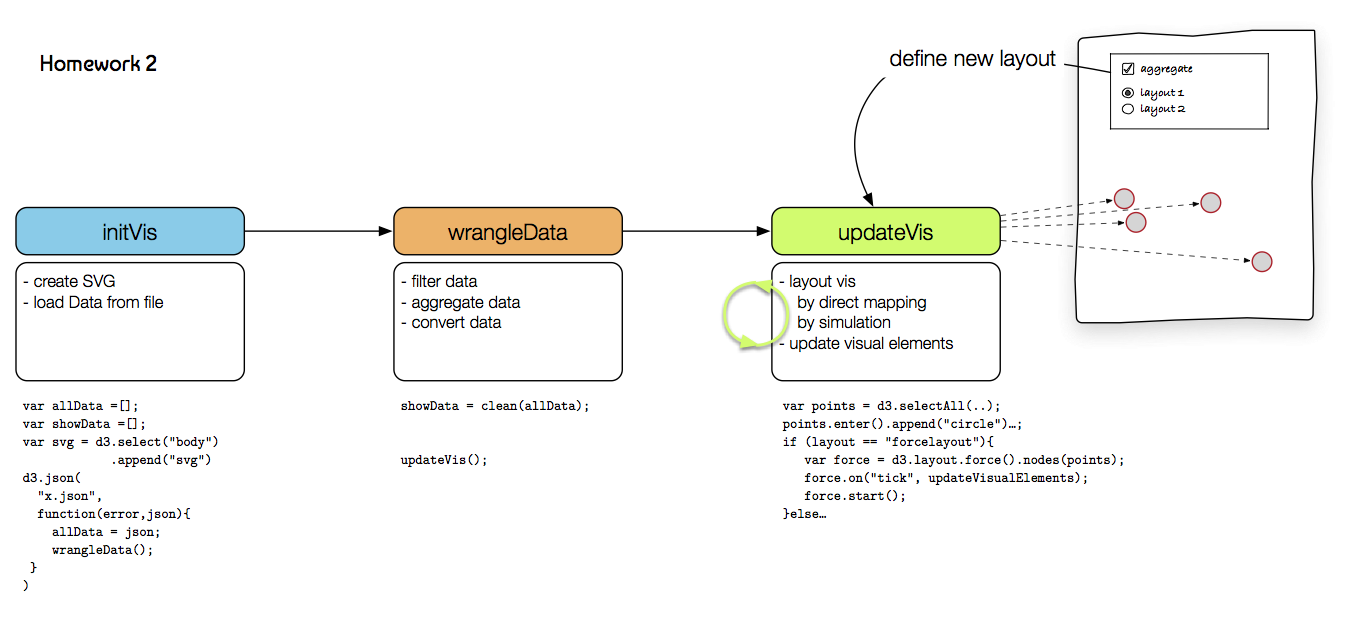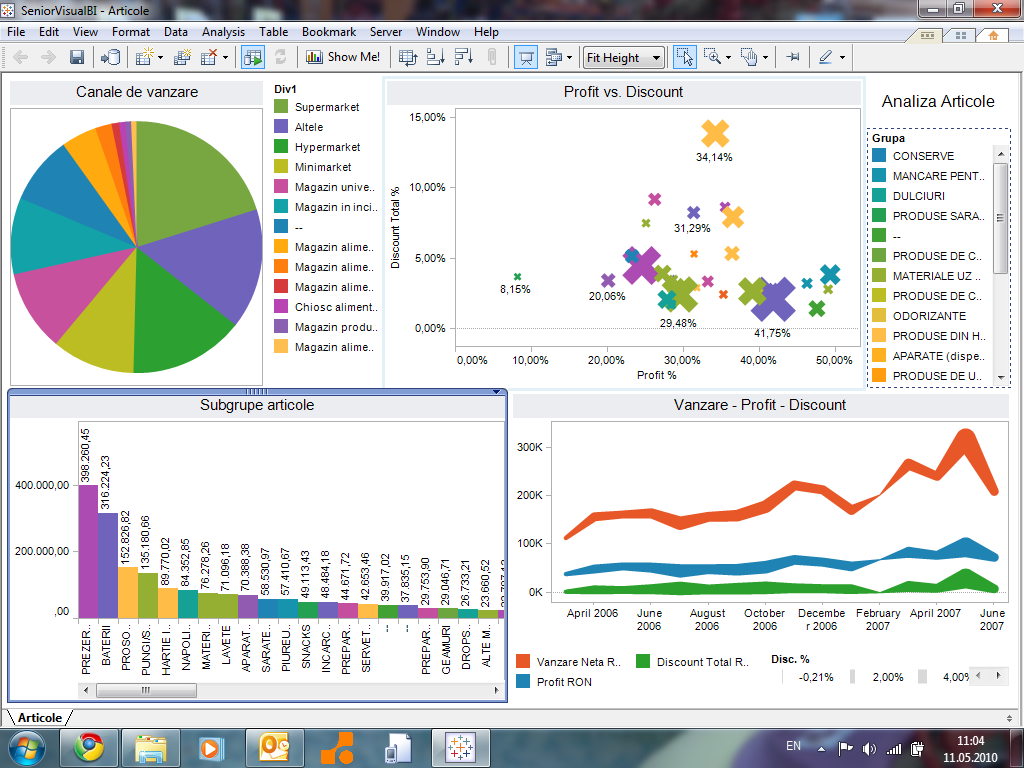This is a short tutorial introducing the basic elements and concepts of D3. D3 stands for Data-Driven Documents and is a very popular JavaScript library written by Mike Bostock.
Homepage: http://d3js.org/
Github: https://github.com/d3/d3
API Documentation: https://github.com/d3/d3/blob/master/API.md
Gallery: https://github.com/mbostock/d3/wiki/Gallery
Examples: everywhere just google it
License: BSD-3-Clause license
Download / Include:
<script src="http://d3js.org/d3.v4.js" charset="utf-8"></script>- https://github.com/d3/d3/releases/latest
SURVEY: What do you guys already know?
- JS - JavaScript / JSON (JavaScript Object Notation)
- CSS - Cascading Style Sheets
- SVG - Scalable Vector Graphics
//variables
let x = 5;
let s = "abc";
let s2 = 'abc';
let arr = [1,2,4];
let obj = { a : 10, b : 'test'};
//access: obj.a or obj['a']
//conditionals
if (x < 10) {
console.log('small');
} else {
console.log('large');
}
let x2 = x < 10 ? 20 : 30;
//loops
for(let i = 0; i < arr.length; i++) {
x += arr[i];
}
// for of
for(let ai of arr) {
x += ai;
}
let i = 0;
while(i < 10) {
x += i++ * 10;
}
//functions
function add(a,b) {
return a + b;
}
let sub = (a,b) => {
return a - b;
}
console.log(add(10,30), sub(10,5));
//functional style programming
arr.forEach((d) => x += d);
let arr2 = arr.map((d) => d* 10);
let arrf = arr.filter((d) => d < 3);
//function are first-level objects
function compute(f, a, b) {
return f(a,b);
};
console.log(compute(add, 20,10));Great way to spearate the style from the actual content. In addition, the selector notation is used for navigation and selections in D3.
Good overview of CSS Selectors: http://code.tutsplus.com/tutorials/the-30-css-selectors-you-must-memorize--net-16048
Most important selectors:
<html>
<body>
<div class="header">
D3 Test
</div>
<div id="main">
<p class="header">Lorem Impsum Header</p>
<p>Lorem Impsum</p>
</div>
</body>
</html>| Selector | Meaning |
|---|---|
div |
select all div elements |
.header |
select elements having class header |
#main |
select the element with the id main |
div.header |
select all div with class header |
div p |
select all descendent p within a div |
div:hover |
matches when the mouse hovers a div |
https://en.wikipedia.org/wiki/Scalable_Vector_Graphics
SVG describes the image to be drawn instead of drawing it.
Example:
<svg>
<circle r="10" cx="20" cy="20" fill="green" />
<rect x="18" y="18" width="30" height="20" style="fill: blue" />
<text x="10" y="30">Test</text>
</svg>
<div></div>Draws a circle at 20,20 (origin is the top left corner) with a radius of 10 filled with a green color. Hint: the order defines the visibility order --> the last one is on top
Some examples: Primitive Examples
Important elements:
circle(cx, cy, r)rect(x, y, width, height)line(x1, y1, x2, y2)text... text as the body of the elementpath(d)... complex shapesg... grouping of elements- Hint:
title... can be a child of each element for creating a decription shown as a tooltip
Important attributes:
style... set CSS style attributefill... fill colorstroke... stroke colortransform... apply a linear transformation on the element and its children (in case of agelement), e.g.,transform="translate(100,10)rotate(90)scale(2,2)"
3 ways for specifying the fill color of an element:
- inline style:
style="fill: green" - fill attribute:
fill="blue" - css rule:
circle { fill: blue; }
Using a good development environment can save you time and prevent you from pain. Editors like Sublime or Atom are a good start. Fully fledged integrated development environments such as WebStorm or Eclipse may be complex at a first glance but provide a bunch of useful features.
The Chrome Developer Tools are a great set of utilities for web development.
Among other you have:
- Web Inspector
- Properties
- CSS Style Selector
- Console
- in-place coding
console.log,console.error
- Debugger
- (Conditional) Breakpoints
- Callstack
- Console context
debuggerstatement a hard-coded breakpoint forcing the debugger to stop (if the developer tools are opened)
- Profiler profile your JS code for bottlenecks
- Network look at all the requests/responses of your website
Every major web browser (Firefox, Safari, Internet Explorer, etc.) has integrated developer tools.
###Local WebServer
While you can view local sites (file:///), Chrome doesn't allow you to load additional external files, e.g., JSON files, for security reasons. Therefore, you need a local webserver running for development. As alternative you can use an integrated IDE (such as WebStorm) that has a webserver already integrated.
Starting a simple python static webserver:
python -m SimpleHTTPServerFull list: https://gist.github.com/willurd/5720255
A fundamental concept in D3 is binding a DOM element to a data item and manipulate the attributes according to the bound data item. For example, you have a list of persons each having two numerical attributes (age, weight) and a categorical one (gender). You bind each person to an SVG circle element and set the circle's x-position according to the age and the y-position according to the weight. If you additionally fill the circle according to the person's gender, you end up with a simple colored scatterplot visualization.
Code: persons.html
All functions of D3 are available under the namespace: d3. The most important functions are select and selectAll. select requires in the simplest form an CSS selector string as argument and returns an selector object for the first matching element only. selectAll returns a list of matched elements respectively. Hint: both functions won't throw an error if no element was found, in either cases they return a dummy selector, having no effect.
let header = d3.select('div.header');Selectors provides a couple of function for manipulating the DOM element including: attr, style, classed, text, and html.
let circle = d3.select('circle');
circle.attr('r', 10);
circle.attr('cx', 20);
circle.attr('cy', 23);
//alternative syntax via chaining
circle.attr('r', 10)
.attr('cx', 20)
.attr('cy', 23);
//set css styles
circle.style('stroke-width', 2);
//add, remove css classes
circle.classed('highlight', true);
//set inner text
d3.select('text').text('Hello');
d3.select('div').html(`<strong>Hello</strong>`);The function come in different shapes: as setter (previous examples) as in a getter version. In the later case the value of the first element in the list will be returned. e.g. circle.attr('cx')
the dom elements can be manipulated using. append and remove
let body = d3.select('body');
body.append('svg').attr('width', 800).attr('height',600);
d3.select('svg').remove();The basic idea of D3 is binding data items to DOM elements and manipulate them accordingly. We can distinguish three different cases when binding a bunch of data items to a set of DOM elements:
for each of the cases we have to tell D3 what to do. e.g. when we have more data items than DOM elements, we are in the enter phase and need to specify a way how to create the remaining ones. Similarly if we more DOM elements than data items we are in the exit phase and need to take care of removing the superfluous ones.
basic workflow:
HTML boilerplate
<svg width="300" height="300">
</svg>const data = [1,2,3];
//select svg element
//select all circles - even if there none yet - and bind the data array *data* onto them
let circles = d3.select('svg').selectAll('circle').data(data);
//enter phase
//append an element matching the selector and set constant attributes
let circles_enter = circles.enter().append('circle');
circles_enter.attr('r', 10);
//update phase ... actually update all including the newly created ones
let circles_update = circles;
let circles_update_and_enter = circles_update.merge(circles_enter);
//function argument given two parameters:
//1. argument (common name: d): the current data item
//2. argument (common name: i): the index of the data item in the data array
//this context: the current DOM element
circles_update_and_enter.attr('cx', (d,i) => d*10);
circles_update_and_enter.attr('cy', (d,i) => i*50);
//exit phase
let circles_exit = circles.exit();
circles_exit.remove();common shortcut
const data = [1,2,3];
let circles = d3.select('svg').selectAll('circle').data(data);
let circles_enter = circles.enter().append('circle')
.attr('r', 10);
circles.merge(circles_enter)
.attr('cx', (d,i) => d*10)
.attr('cy', (d,i) => i*50);
circles.exit().remove();Hint: common pitfall
let data = [1,2,3];
let circles = d3.select('svg').selectAll('circle').data(data)
.enter().append('circle')
.attr('r', 10);
//what is the difference to the previous one?
circles
.attr('cx', (d,i) => d*10)
.attr('cy', (d,i) => i*50);
//exit is not defined?
circles.exit().remove();This is a common pitfall when using d3 resulting from premature optimization. In this case it circles stores the enter-phase instead of the generic data-join selection. This happens quite often you just create a visualizations but don't think about updating your visualization. The first error is that the exit function is not defined. The severe problem is that the next time you run the same function even with modified dataset, the attributes cx and cy won't be updated. The reason is that the enter-phase selector is empty, since there is no need for new DOM elements.
INTERACTIVE: creating a bar chart: barchart01_initial.html Open in Codepen
Nested selections can be used for adding inner elements. A common approach is creating one g element for each data item and add several sub DOM elements. The sub element will be created during the enter-phase and updated using select. By using select function the data-join remains using selectAll a nested data join will be created. Nested data joins are useful for hierarchical data.
nested data join
//hierarchical data
const data = [{ name: 'a', arr: [1,2,3]}, { name: 'b', arr: [3,2,4] }];
let groups = d3.select('svg').selectAll('g').data(data);
let groups_enter = groups.enter().append('g')
let groups_update = groups.merge(groups_enter)
.attr('transform', (d, i) => `translate(${i * 20 + 10},10)`);
//select all circles within each group and bind the inner array per data item
let circles = groups_update.selectAll('circle').data((d) => d.arr);
//normal data-join
let cirles_update = circles.enter().append('circle');
circles.merge(cirles_update)
.attr('r', (d) => d*2)
.attr('cy',(d,i) => i*20);
circles.exit().remove();
groups.exit().remove();nested selection
const data = [1,2,3];
let circles = d3.select('svg').selectAll('circle').data(data);
let circles_enter = circles.enter().append('circle')
.attr('r', 10);
circles_enter.append('title');
let circles_update = circles.merge(circles_enter)
.attr('cx', (d,i) => d*10)
.attr('cy', (d,i) => i*50);
circles_update.select('title').text((d) => d);
circles.exit().remove();INTERACTIVE: adding a title attribute: barchart02_title.html Open in Codepen
In the current version we have static hard-coded data in our files. D3 provides a bunch of function for loading external files. The most important ones are d3.json for loading JSON files and d3.csv for CSV files respectively. Important Data Loading is asynchronous. That means you won't get the data immediately as a return value. But you are handing in a callback function, as soon as the data are ready. You can't predict when this happens. You have to structure your code accordingly.
d3.json('file_to_load.json', (error, data) => {
if (error) {
console.error('cant load data');
} else {
//do something with the data
}
});Hint: D3 is smart enough, when just one argument is given that it will interpreted as the data argument
d3.csv('file_to_load.csv', (error, data) => {
if (error) {
console.error('cant load data');
} else {
//array of objects
console.log(data.length);
//do something with the data
}
});see also: https://github.com/d3/d3-request/blob/master/README.md#csv for formatting and parsing options
Warning: Chrome doesn't allow that local files access other local files using XmlRequests by default. (Firefox does). So, you need a local webserver running on your machine
INTERACTIVE: loading weather.json: barchart03_json.html Open in Codepen
As seen in the barchart example, mapping a value to a pixel value manually is a pain. D3 provides scales for this case. The idea is creating a mapping function between the domain values (data space) and the output range (pixel space).
D3 provides different scales:
- quantitative
d3.scaleLinear()... linear mapping between domain and ranged3.scalePow()d3.scaleLog()
- ordinal
d3.scaleOrdinal()
d3.scaleBand()d3.scalePoint()- predefined categorical color scales:
d3.scaleOrdinal(d3.schemeCategory10)d3.scaleOrdinal(d3.schemeCategory20)... special property: dark/bright pairsd3.scaleOrdinal(d3.schemeCategory20b)... 4 brightness levels per colord3.scaleOrdinal(d3.schemeCategory20c)... 4 brightness levels per color
const scale = d3.scaleLinear().domain([0,5]).range([0,200]);
const cscale = d3.scaleLinear().domain([0,5]).range(['black','white']);
...
//the scale can be applied as a function
circles_update
.attr('cx', (d) => scale(d))
.style('fill', (d) => cscale(d));//domain is a list of strings or numbers
const scale = d3.scaleOrdinal().domain(['a','b','c']).range([10,20,30]);
//distribute as a band for each item
const bscale = d3.scaleBand().domain(['a','b','c']).range([0,200]);
...
//the scale can be applied as a function
circles.attr('cx', (d) => scale(d));In addition, it is quite common adding a axis for your charts. D3 provides a utility function for this case : d3.svg.axis(). It uses a scale as input and the necessary SVG elements for you.
const scale = d3.scaleLinear().domain([0,5]).range([0,200]);
const axis = d3.axisBottom().scale(scale);
//create a container to put the axis
const axis_container = d3.select('svg').append('g')
.attr('class', 'axis')
.attr('transform', 'translate(0,200)');
//call axis to create the SVG elements for you
axis_container.call(axis);INTERACTIVE: adding linear and ordinal scale: barchart04_scale.html Open in Codepen
Interactivity is event-driven as in the usual DOM. However, you have easy access to the currently bound data-item. The raw DOM event is hidden but can be accessed using d3.event. This is useful for stopping the event propagation (bubbling) d3.event.stopPropgation() or preventing the default behavior d3.event.preventDefault(). Moreover, the current context of the function this is the current DOM element.
const data = [1,2,3];
let circles = d3.select('svg').selectAll('circle').data(data);
circles.enter().append('circle')
.attr('r', 10)
.attr('cy', 40)
.attr('cx', (d,i) => 30+i*30)
.on('click', function(d, i) {
console.log(`clicked on: ${d} (${i})`);
const circle = d3.select(this); //can't use arrow scoping
circle.style('stroke', 'orange');
});commonly used events: click, mouseover/mouseout, mouseenter/mouseleave, change, input
INTERACTIVE: filter US cities: barchart05_interactive.html Open in Codepen
Animated transitions can help the user understanding changes and are just fun to watch. Transitions in D3 are very simple. Just add .transition() within a selector and the changes afterwards are done in an animated fashion. D3 is very smart when it comes to interpolating values, colors, and much more. Transitions can be used during all phases: enter, update, and exit. By nesting transitions you can create fancy animations with just a bunch line of code.
const data = [1,2,3];
let circles = d3.select('svg').selectAll('circle').data(data);
let circles_enter = circles.enter().append('circle')
.attr('r', 10)
.attr('cx', 100)
.attr('cy', 100); //useful default values for animation
circles.merge(circles_enter)
.transition()
.duration(1000) //duration of the animation
.delay(200) //delay animation start
.attr('cx', (d,i) => d*50)
.attr('cy', (d,i) => 40+i*100)
.transition() //start another transition after the first one ended
.attr('r', 20);
circles.exit().remove();D3 is rather dumb when it comes to mapping data items to DOM elements. It doesn't take the order into account. So, if element 'a' was previously at the first position and now on the third it will bind it to the third element. However, this hampers animations, i.e. animated sorting. By using the key argument of the data function, one can force that the same DOM element is bound to the same data item regardless of the item order.
const cscale = d3.scaleOrdinal(d3.schemeCategory10).domain(['a','b','c', 'd']);
const xscale = d3.scaleBand().domain(['a','b','c', 'd']).range([10,200]);
function update(data) {
let s = d3.select('svg');
//key argument return a unique key/id per data-item (string)
let circles = s.selectAll('circle').data(data, (d) => d);
//a will be bound to the first DOM element
let circles_enter = circles.enter().append('circle')
.attr('r', 10)
.attr('cx', xscale)
.style('fill', cscale);
circles.merge(circles_enter)
.transition()
.attr('cy', (d,i) => 10+i*20)
circles.exit().remove();
}
let data = ['a','b','c'];
update(data);
//later on... 2secs
setTimeout(() => {
data = ['c','a','d'];
//the items will move to their new position,
//and the DOM element for 'b' will be removed
//and another one for 'd' created
update(data);
}, 2000)INTERACTIVE: animated filter: barchart06_interactive.html Open in Codepen
INTERACTIVE: final results barchart07_final.html Open in Codepen
D3 provides a bunch of standard layouts. A layout does not actually render the visualization but prepares your data, such that you can render, e.g. a pie chart. Most of the time the work with helper tools for SVG from D3. e.g. the d3.layout.pie() works best with d3.svg.arc().
A full list of all available layouts can be found at: https://github.com/mbostock/d3/wiki/Layouts
example including a feedback loop:
example including a layout simulation:
A pie-layout is a simple layout algorithm. It takes the data and a way to sort/compute the value per slice. It wraps the data and enhance it with additional attributes for the pie slice, such as start end end angle. Hint the angles and arcs are computed relatively to the pie's center. The computed attributes with another utility function d3.svg.arc() which converts the given values to a SVG path.
SEE: pie.html
A force layout is a graph layout algorithm, which uses a simulation for positioning nodes. The goal is to minimize the force applied on the system introduced by gravity, node repulsive force, and edge attraction forces. In this case it is not a one layout step, but a continuous one, where on each tick a new set of positions are available.
SEE: miserables.html
- Geo Projection: GeoJSON, TopoJSON, Projection: https://github.com/mbostock/d3/wiki/Geo-Projections
- Time: Scales, Formatting/Parsing, ...
- Behaviors:
- Zoom
- Drag
- Array Utilities:
d3.sum,d3.max,d3.set,d3.map - Selector Utilities:
.sort(),.filter(),.raise(),.lower()
online: http://codepen.io/sgratzl/pen/mOwrxO/ Github repository: https://github.com/sgratzl/d3boilerplate
The big player for commercial fat client data visualization.
commercial JavaScript Plot library
https://processing.org/ and http://processingjs.org/ for a web-version
own programming language for visualizations with OpenGL backend
e.g. Plot.ly (https://plot.ly/) - chart creation
- NVD3 (http://nvd3.org/) - reusable plots on top of D3
- Cubism (https://square.github.io/cubism/) - Time Series Data
- Vega (http://trifacta.github.io/vega/) - declarative description of plots
- Crossfilter (http://square.github.io/crossfilter/) - Fast Multidimensional Filtering for Coordinated Views
- ...
Thank You







